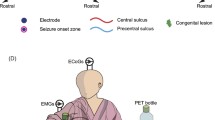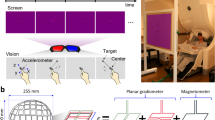Abstract
Brain-machine interface (BMI) efforts have been focused on using either invasive implanted electrodes or training-extensive conscious manipulation of brain rhythms to control prosthetic devices. Here we demonstrate an excellent prediction of movement trajectory by real-time magnetoencephalography (MEG). Ten human subjects copied a pentagon for 45 s using an X-Y joystick while MEG signals were being recorded from 248 sensors. A linear summation of weighted contributions of the MEG signals yielded a predicted movement trajectory of high congruence to the actual trajectory (median correlation coefficient: r = 0.91 and 0.97 for unsmoothed and smoothed predictions, respectively). This congruence was robust since it remained high in cross-validation analyses (based on the first half of data to predict the second half; median correlation coefficient: r = 0.76 and 0.85 for unsmoothed and smoothed predictions, respectively).


Similar content being viewed by others
References
Georgopoulos AP, Kettner RE, Schwartz AB (1988) Primate motor cortex and free arm movements to visual targets in three-dimensional space. II. Coding of the direction of movement by a neuronal population. J Neurosci 8:2928–2937
Hinterberger T, Weiskopf N, Veit R, Wilhelm B, Betta E, Birbaumer N (2004) An EEG-driven brain-computer interface combined with functional magnetic resonance imaging (fMRI). IEEE Trans Biomed Eng 51:971–974
Leuthold AC (2003) Subtraction of heart artifact from MEG data: The matched filter revisited. Soc Neurosci Abstr 863.15
McFarland DJ, McCane LM, David SV, Wolpaw JR (1997) Spatial filter selection for EEG-based communication. EEG Clin Neurophysiol 103:386–394
Scherer R, Muller GR, Neuper C, Graimann B, Pfurtscheller G (2004) An asynchronously controlled EEG-based virtual keyboard: improvement of the spelling rate. IEEE Trans Biomed Eng 51:979–984
Taylor DM, Tillery SI, Schwartz AB (2002) Direct cortical control of 3D neuroprosthetic devices. Science 296:1829–1832
Vetter RJ, Williams JC, Hetke JF, Nunamaker EA, Kipke DR (2004) Chronic neural recording using silicon-substrate microelectrode arrays implanted in cerebral cortex. IEEE Trans Biomed Eng 51:896–904
Wessberg J, Nicolelis MA (2004) Optimizing a linear algorithm for real-time robotic control using chronic cortical ensemble recordings in monkeys. J Cogn Neurosci 16:1022–1035
Wolpaw JR, McFarland DJ (2004) Control of a two-dimensional movement signal by a noninvasive brain-computer interface in humans. Proc Natl Acad Sci U S A 101:17849–17854
Wolpaw JR, Birbaumer N, Heetderks WJ, McFarland DJ, Peckham PH, Schalk G, Donchin E, Quatrano LA, Robinson CJ, Vaughan TM (2000) Brain–computer interface technology: a review of the first international meeting. IEEE Trans Rehab Eng 8:164–173
Acknowledgements
This work was supported by the MIND Institute (Albuquerque, NM), the U.S. Department of Veterans Affairs, and the American Legion Brain Sciences Chair.
Author information
Authors and Affiliations
Corresponding author
Rights and permissions
About this article
Cite this article
Georgopoulos, A.P., Langheim, F.J.P., Leuthold, A.C. et al. Magnetoencephalographic signals predict movement trajectory in space. Exp Brain Res 167, 132–135 (2005). https://doi.org/10.1007/s00221-005-0028-8
Received:
Accepted:
Published:
Issue Date:
DOI: https://doi.org/10.1007/s00221-005-0028-8




